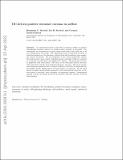DC-driven positive streamer coronas in airflow
Author(s)
Martell, Benjamin C; Strobel, Lee R; Guerra-Garcia, Carmen
DownloadSubmitted version (8.372Mb)
Open Access Policy
Open Access Policy
Creative Commons Attribution-Noncommercial-Share Alike
Terms of use
Metadata
Show full item recordAbstract
<jats:title>Abstract</jats:title>
<jats:p>An experimental study of the effect of airflow on positive self-pulsating streamer coronas in a needle-to-plate geometry is presented. The experiments are performed in an open return wind tunnel with winds up to 30 m s<jats:sup>−1</jats:sup> orthogonal to the needle. The experimental data is presented in terms of statistical properties of the discharge, inferred from high resolution, large sample-size current waveforms. The key properties of the current pulsations, namely inter-pulse period, peak current, deposited energy, and pulse width are analyzed as a function of wind speed and applied DC voltage. All parameters increase in dispersion with wind speed. The mean of the inter-pulse period decreases with wind speed and the mean pulsation frequency increases. The peak currents and energies per pulsation have a general tendency to decrease in magnitude but also higher-current, higher-energy, streamer bursts are observed. At low wind speeds, streamers preferentially propagate in the downwind direction but, as the wind speed is increased, more streamers can propagate upwind. The measurements are interpreted using an analytical model of charge transport.</jats:p>
Date issued
2022-08-01Department
Massachusetts Institute of Technology. Department of Aeronautics and AstronauticsJournal
Plasma Sources Science and Technology
Publisher
IOP Publishing
Citation
Martell, Benjamin C, Strobel, Lee R and Guerra-Garcia, Carmen. 2022. "DC-driven positive streamer coronas in airflow." Plasma Sources Science and Technology, 31 (8).
Version: Original manuscript